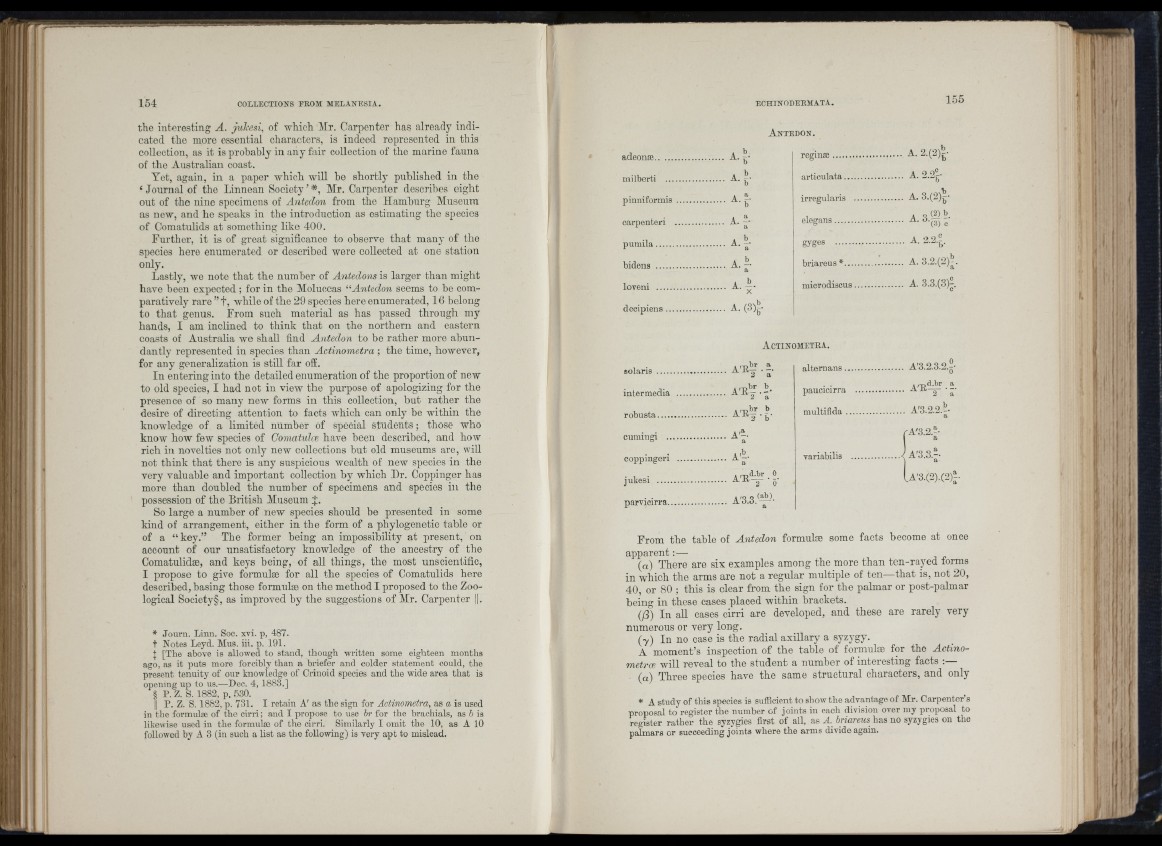
-i
the interesting A. jukesi, of which Mr. Carpenter has already indicated
the more essential characters, is indeed represented in this
collection, as it is probably in any fair collection of the marine fauna
of the Australian coast.
Yet, again, in a paper which will be shortly published in the
‘ Journal of the Linnean Society’ *, Mr. Carpenter describes eight
out of tho nine specimens of Antedon from the Hamburg Museum
as new, and he speaks in the introduction as estimating the species
of Comatulids at something like 400.
Further, it is of great significance to observe th at many of the
species here enumerated or described were collected at one station
only.
Lastly, we note th a t the number of Antedonsi^ larger than might
have been expected ; for in the Moluccas “Antedon seems to be comparatively
rare ” t , while of the 29 species here enumerated, 16 belong
to th at gonus. From such material as has passed through my
hands, I am inclined to think th at on the northern and eastern
coasts of Australia we shall find Antedon to be rather more abundantly
represented in species than Actinometra; the time, however,
for any generalization is still far off.
In entering into the detailed enumeration of the proportion of new
to old species, I had not in view the purpose of apologizing for the
presence of so many new forms in this collection, but rather the
desire of directing attention to facts which can only he within the
knowledge of a limited number of special students; those who
know how few species of Comatulce have been described, and how
rich in novelties not only new collections but old museums are, will
not think th at there is any suspicious wealth of new species in the
very valuable and important collection by which Dr. Coppinger has
more than doubled the number of specimens and species in the
possession of the British Museum j .
So large a number of new species should he presented in some
kind of arrangement, either in the form of a phylogenetic table or
of a “ key.” The former being an impossibility at present, on
account of our unsatisfactory knowledge of the ancestry of tho
Comatulidse, and keys being, of all things, the most unscieniific,
I propose to give formulEe for all the species of Comatulids here
described, basing those formula? on the method I proposed to the Zoological
Society§, as improved by the suggestions of Mr. Carpenter ||.
* Journ. Linn. Soc. xvi. p, 487.
t Notes Leyd. Mus. iii. p. 191.
t [The above is allowed to stand, though written some eighteen months
airo, as it puts more forcibly than a briefer and colder statement could, the
present tenuity of our knowledge of Crinoid species and the wide area that is
opening up to ns.—Dec. 4, 188A]
§ P . Z . S . 1 8 8 2 , p . 5 3 0 .
II P. Z. S. 1882, p. 731. I retain A' as the sign for Actinometra, as a is used
in the formnliE of the cirri; and I propose to use hr for the brachials, as h is
likewise used in the formula? of the cirri. Similarly I omit the 10, as A 10
follow'ed by A 3 (in such a list as the following) is very apt to mislead.
Antedon.
adeonæ................. ........ A b^ reglnEe........................... A. 2.(2)^-
milberti ............. ........ articulata....................... A.
pinniformis .........
carpenteri ......... A. Aa
irregularis ...................
elegans...........................
A. 3.{2 )l
A- A (3) e
pumila................. A.Ì1a- gyges ........................... A. 2.2.2.
bidens ................. A. Ea
briareus *....................... A. 3,2.(2)J.
loveni ................ ......... 7 microdiscus................... A. 3.3.(3)2
decipiens............. ......... A- ( +
Actinometra.
Solaris ................
intermedia .........
......... A 'E ÿ .A
.........
alternans.......................
paucicirra ...................
A'3.2.3.2.3-
A'E‘*2 f ■ Aa
robusta................ ......... a'e Ç.,^. multifida....................... A'3.2,2.-acumingi
............ ......... A’A ''A'3.2.A
coppingeri ........
jukesi ................
parvicirra............
A’^a-
A'E'ÜT . ?.
A'3.3.'—-7
a
variabilis ................... A'3.3.-a-
A'3.(2).(2)^
From the table of Antedon formuliE some facts become at once
ap p a ren t:—
(a) There are six examples among the more than ten-rayed forms
in which the arms are not a regular multiple of ten—that is, not 20,
40, or 80 ; this is clear from the sign for the pahnar or post-palmar
being in these cases placed within brackets.
(j3) In all cases cirri are developed, and these are rarely very
numerous or very long.
(y) In no case is the radial axillary a syzygy.
A moment’s inspection of the table of formulse for the Actinometrce
will reveal to the student a number of interesting facts
(a) Three species have the same structural characters, and only
* A study of this species is sufficient to show the advantage of Mr. Carpenter’s
proposal to register the number of joints in each division over my proposal to
register rather the syzygies first of all, as A. briareus has no syzygies on the
palmars or succeeding joints where the arms divide again.
! i:
'i M
f
(